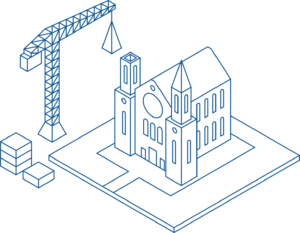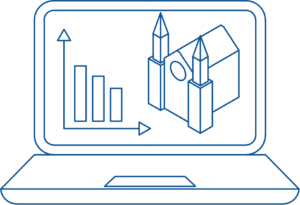Our goal is to make the most of the methodology based on Building Information Modeling (BIM) to provide a support tool to both local authorities, especially in the planning of interventions and emergency management, and to the technicians who are preparing to intervene on single units or entire aggregates.
The BIM methodology has been designed, perfected, regulated and validated over time and today finds numerous applications, some of which are reported below.
 ... Facility Management
... Facility Management

One of the advantages that can be gained from the creation of an as-built BIM model is certainly the optimization of the activities related to the management of the building.
Today the IT tools of Facility Management interface with the BIM models for the management of services related to the building (ordinary and extraordinary maintenance), to the person (concierge services, security, canteen, etc.) and spaces (furniture, healthiness and environmental comfort).
For example, from the BIM models it is possible to easily query all the information related to the maintenance of a building element, in order to promptly and optimally plan the interventions.
 ... Knowledge
... Knowledge

Through the use of a computer or mobile devices, such as smartphones, tablets or smart glass, information that increases perceived reality can be added to your screen. While a webcam captures the surrounding world, software, which are able to recognize special markers (AR tags), overlap additional content such as documents, video, audio, 3D objects, etc. to the real image.
 ... Project & Renovation
... Project & Renovation

In Italy and the rest of the world, governments are promoting the adoption of BIM as an operational tool for managing public projects.
The next regulations will also impose the obligation to use BIM.
 ... Monitoring
... Monitoring

The BIM model allows to have a digital version true to reality. This makes it possible to compare the theoretical data with the status of fact to monitor the static, energy and environmental performance of the building.
This activity finds application in the field of seismic and hydrogeological monitoring of risk areas, on-site inspections, up to the comparison between contractual service levels (SLA) and key performance indicators (KPI) in facility management.
To optimize the monitoring, the digital models can be connected with hardware instruments (probes, laser scanner, etc.) able to highlight any anomalies in real time.
 ... Big Data
... Big Data

Big Data refers to those systems that can handle a massive number of data. The information is characterized by the so-called “3V”:
Volume, ie the large number of data;
Velocity, information generation speed;
Variety, or the heterogeneity of the same.
To these characteristics two other V have been added:
Truthfulness, the high number of information generated in a short time does not always guarantee their reliability)
Value: refers to the ability to transform data into value.
The management of big data has been applied in many sectors, from agriculture to medicine, as its use is aimed at improving decision-making activities.
The use of BIM applied on a territorial scale, which can contain information related to a real estate portfolio, to the cultural heritage of a city, up to a large number of agricultural land, allows upstream management of data characterized by the 5V listed that can be easily interrogated and related (for example by Business Intelligence systems) to optimize strategic planning activities.

